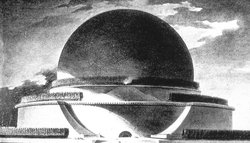|
|
| Missing image Bibliotheque_nationale_boul.jpg Boullée, Deuxieme projet pour la Bibliotheque du Roi (1785) |
Étienne-Louis Boullée (February 12, 1728 - February 6, 1799) was a French neoclassical architect whose work greatly influenced contemporary architects and is still influential today.
Born in Paris, he studied under Jacques-François Blondel, Germain Boffrand and Jean Laurent Legeay, from whom he learned of the French revival of Classical architecture in the 17th and 18th century. He was elected to the Académie Royale d'Architecture in 1762 and became chief architect to the King of Prussia. He designed a number of private houses from 1762 to 1778, though most of these no longer exist; notable survivors include the Hôtel Alexandre and Hôtel de Brunoy, both in Paris.
It was as a teacher and theorist at the École Nationale des Ponts et Chaussées between 1778 and 1788 that he made his biggest impact, developing a distinctive abstract geometric style inspired by Classical forms. It was characterised by the removal of all unneccessary ornamentation, inflating pure forms to a huge scale and repeating elements such as columns in huge ranges. He promoted the idea of making architecture expressive of its purpose (a doctrine that he termed architecture parlante, "talking architecture"). His style was most notably exemplified in his proposal for a cenotaph for the English scientist Isaac Newton, which would have taken the form of a sphere 150 m (500 ft) high embedded in a circular base topped with cypress trees. This was, however, never built.
Boullée's ideas had a major influence on his contemporaries, not least because of his role in teaching other important architects such as Chalgrin, Brongniart, and Durand. Some of his work only saw the light of day in the 20th century; his book Architecture, essai sur l'art (essay on the art of architecture), arguing for an emotionally committed Neoclassicism, was only published in 1953. The volume contained his work from 1778 to 1788, which mostly comprised designs for public buildings on a wholly impractical grand scale.
Boullée's fondness for grandoise designs has caused him to be characterized as both a megalomaniac and a visionary. His focus on polarity (offsetting opposite design elements) and the use of light and shadow was highly innovative, and continues to influence architects to this day. He was "rediscovered" in the 20th century and has influenced recent architects such as Aldo Rossi.
Bibliography
- Boullée & visionary architecture ed. Helen Rosenau, Pub. Harmony Books, New York, 1976 ISBN 0856701572.
- Boullée's Treatise on Architecture by Étienne-Louis Boullée, ed. by Helen Rosenau, pub. Alec Tiranti, Ltd. London: 1953 First Edition
- Étienne-Louis Boullée (1728-1799: Theoretician of Revolutionary Architecture) by Jean Marie Perouse De Montclos, pub.George Braziller; ISBN 0807606723; (February 1974)
- Visionary Architects: Boullée, Ledoux, Lequeu by Jean-Claude Lemagny, pub. Hennessey & Ingalls; ISBN 0940512351; (July 2002)
- Les Architectes de la Liberté by Annie Jacques, pub. Découvertes Gallimard #47; ISBN 2070530671; (November 1988) [In French]
- A Dictionary of Architecture, James Stevens Curl, Oxford University Press (1999).
- "Boullée, Etienne-Louis (1728 - 1799)", The Hutchinson Encyclopedia, Helicon (2001).
- "Boullée, Etienne-Louis (1728 - 1799)", Crystal Reference Encyclopedia (2001).
External links
- Boullée exhibit at Bibliothèque nationale de France http://expositions.bnf.fr/boullee/index.htm
- Internet architecture resource http://www.vitruvio.ch/arc/masters/boullee.htm
- Successor to the Académie Royale d' Architecture http://www.academie-des-beaux-arts.fr
- Movie: The Belly of an Architect 1987 dir. Peter Greenaway http://us.imdb.com/Title?0092637es:Étienne-Louis Boullée

